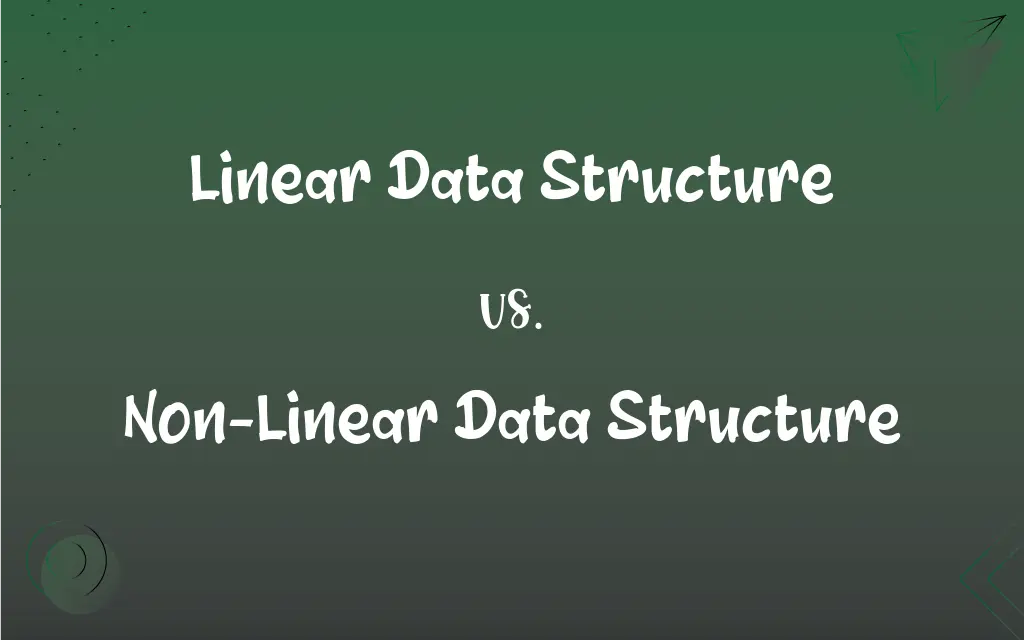Linear Data Structure vs. Non-Linear Data Structure: What's the Difference?
Edited by Aimie Carlson || By Janet White || Published on March 3, 2024
Linear data structures store elements sequentially, allowing single-level traversal, while non-linear data structures store elements hierarchically or in a connected manner, enabling multi-level traversal.

Key Differences
In a linear data structure, elements are arranged in a sequential order where each element is connected to its previous and next element. This arrangement facilitates easy insertion, deletion, and traversal operations in a single level. Examples include arrays, linked lists, stacks, and queues. Conversely, non-linear data structures, such as trees and graphs, have elements that are not arranged sequentially. Instead, they are connected in a hierarchical or networked manner, allowing for complex relationships and multi-level traversal.
Linear data structures are known for their simplicity and ease of use. They provide a straightforward method to access their elements, usually through a single loop. Operations in linear structures like searching or sorting can be performed with relatively simple algorithms. On the other hand, non-linear data structures are more complex and are used to represent more complex relationships. They require more sophisticated algorithms for operations like traversal, as seen in depth-first or breadth-first search in trees and graphs.
When it comes to memory allocation, linear data structures can be either static, like arrays, or dynamic, like linked lists. Static structures have fixed memory size, whereas dynamic structures can adjust their size during runtime. Non-linear data structures, however, generally require dynamic memory allocation, as their size and structure may change frequently, particularly in the case of trees where nodes can be added or removed.
Linear data structures are typically used in scenarios where data can be easily represented in a single dimension. They are suited for applications like data buffering (queues), reversing data (stacks), and simple list management (arrays and linked lists). Non-linear data structures are ideal for representing hierarchical relationships, like organizational structures (trees), or networked connections (graphs), where data is not linearly connected.
The choice between linear and non-linear data structures depends on the specific requirements of the application. Linear structures are often preferred for their simplicity and lower overhead, particularly in applications with straightforward data storage and retrieval needs. Non-linear structures are chosen for complex data relationships and when data needs to be represented in multiple dimensions, offering more flexibility but at the cost of greater complexity.
ADVERTISEMENT
Comparison Chart
Element Arrangement
Sequentially arranged
Hierarchically or networked arrangement
Traversal Method
Single-level traversal (linear)
Multi-level traversal (hierarchical, networked)
Complexity
Simple and easy to understand and implement
More complex, suitable for representing complex relationships
Memory Allocation
Can be static (arrays) or dynamic (linked lists)
Generally requires dynamic allocation
Typical Use Cases
Data buffering, reversing data, simple list management
Representing hierarchical structures, complex networks
ADVERTISEMENT
Linear Data Structure and Non-Linear Data Structure Definitions
Linear Data Structure
A linear data structure arranges elements in a sequential order.
An array is a basic linear data structure used for storing elements in a contiguous memory location.
Non-Linear Data Structure
Non-linear data structures organize data in a hierarchical manner, allowing for multiple levels of relationship.
A tree is a non-linear data structure that represents hierarchical relationships, like a family tree.
Linear Data Structure
It allows for easy insertion, deletion, and traversal in a single level.
A linked list, a linear data structure, enables efficient insertion and deletion of elements.
Non-Linear Data Structure
Non-linear data structures are adept at representing complex and dynamic relationships between data points.
A graph, a non-linear data structure, effectively represents the complex relationships in social networks.
Linear Data Structure
Linear data structures are preferred for straightforward data storage and retrieval.
Arrays, a fundamental linear data structure, are widely used for storing a list of elements of the same type.
Non-Linear Data Structure
Non-linear data structures include both hierarchical models like trees and graph-based models like networks.
A heap, a kind of binary tree, is a non-linear data structure used in priority queue implementation.
Linear Data Structure
Linear data structures can be either static or dynamic.
Stacks, a type of linear data structure, can be implemented using static arrays or dynamic linked lists.
Non-Linear Data Structure
Non-linear data structures allow navigation in multiple directions, not confined to a single path.
In a binary tree, a type of non-linear data structure, you can navigate both upwards and downwards.
Linear Data Structure
They are characterized by their single dimensionality in data representation.
Queues, a linear data structure, are used for FIFO (First In First Out) data management.
Non-Linear Data Structure
In non-linear data structures, elements are interconnected rather than sequential, forming complex relationships.
Graphs, as non-linear data structures, are used to model networks where nodes are interconnected.
FAQs
What are the advantages of linear data structures?
They are easy to implement and efficient in accessing elements in a sequential manner.
How does a linked list differ from an array?
Unlike arrays, linked lists store elements non-contiguously, with each element pointing to the next.
Can you give examples of linear data structures?
Common examples include arrays, linked lists, stacks, and queues.
What is a linear data structure?
A linear data structure organizes data in a sequential manner, where elements are arranged in a linear order.
What is a stack?
A stack is a linear data structure that follows the Last In First Out (LIFO) principle for accessing elements.
How are elements accessed in linear data structures?
Elements in linear data structures are accessed sequentially, either from the beginning or through the use of indices (as in arrays).
What are the limitations of linear data structures?
They can be inefficient in terms of memory and time when dealing with large data or when frequent insertion and deletion are required.
Can you give examples of non-linear data structures?
Examples include trees, graphs, heaps, and hash tables.
What is an array?
An array is a collection of elements stored at contiguous memory locations, accessible by indices.
What is a queue?
A queue is a linear data structure that follows the First In First Out (FIFO) principle for accessing elements.
What is a binary tree?
A binary tree is a type of tree where each node has at most two children, commonly referred to as the left and right child.
What is a tree in data structures?
A tree is a hierarchical data structure with a root element and sub-elements forming a branching structure.
Where are non-linear data structures commonly used?
Common uses include database indexing, representing networks, and organizing hierarchical data like file systems.
Where are linear data structures commonly used?
They are widely used in applications where data is naturally arranged in order, like implementing undo functionality (stack) or managing queues in systems.
What is a non-linear data structure?
Non-linear data structures store data in a hierarchical or interconnected manner, without a strict sequential order.
What is a heap?
A heap is a specialized tree-based data structure that satisfies the heap property, typically used in implementing priority queues.
What are the advantages of non-linear data structures?
They are suitable for representing complex relationships and are efficient in specific operations like searching, sorting, and indexing.
How does a graph differ from a tree?
Unlike trees, graphs can have cycles and do not necessarily have a hierarchical structure. Nodes in graphs can have multiple connections.
How is a hash table different from an array?
A hash table uses a hash function to compute an index into an array of buckets or slots, enabling efficient data retrieval.
What are the limitations of non-linear data structures?
They can be complex to implement and understand, especially for beginners.
About Author
Written by
Janet WhiteJanet White has been an esteemed writer and blogger for Difference Wiki. Holding a Master's degree in Science and Medical Journalism from the prestigious Boston University, she has consistently demonstrated her expertise and passion for her field. When she's not immersed in her work, Janet relishes her time exercising, delving into a good book, and cherishing moments with friends and family.
Edited by
Aimie CarlsonAimie Carlson, holding a master's degree in English literature, is a fervent English language enthusiast. She lends her writing talents to Difference Wiki, a prominent website that specializes in comparisons, offering readers insightful analyses that both captivate and inform.
































































